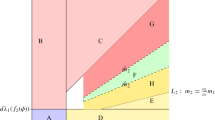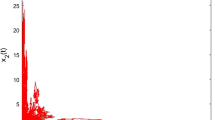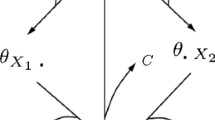Abstract
We study a model of competition for resource through a chemostat-type model where species consume the common resource that is constantly supplied. We assume that the species and resources are characterized by a continuous trait. As already proved, this model, although more complicated than the usual Lotka–Volterra direct competition model, describes competitive interactions leading to concentrated distributions of species in continuous trait space. Here we assume a very fast dynamics for the supply of the resource and a fast dynamics for death and uptake rates. In this regime we show that factors that are independent of the resource competition become as important as the competition efficiency and that the direct competition model is a good approximation of the chemostat. Assuming these two timescales allows us to establish a mathematically rigorous proof showing that our resource-competition model with continuous traits converges to a direct competition model. We also show that the two timescales assumption is required to mathematically justify the corresponding classic result on a model consisting of only finite number of species and resources (MacArthur in, Theor Popul Biol 1:1–11, 1970). This is performed through asymptotic analysis, introducing different scales for the resource renewal rate and the uptake rate. The mathematical difficulty relies in a possible initial layer for the resource dynamics. The chemostat model comes with a global convex Lyapunov functional. We show that the particular form of the competition kernel derived from the uptake kernel, satisfies a positivity property which is known to be necessary for the direct competition model to enjoy the related Lyapunov functional.



Similar content being viewed by others
References
Abrams PA, Rueffler C (2009) Coexistence and limiting similarity of consumer species competing for a linear array of resources. Ecology 90:812–822
Abrams PA, Rueffler C, Dinnage R (2008) Competition-similarity relationships and the nonlinearity of competitive effects in consumer-resource systems. Am Nat 172:463–474
Barles G, Mirrahimi S, Perthame B (2009) Concentration in Lotka–Volterra parabolic or integral equations: a general convergence result. Methods Appl Anal 16(3):321–340
Barles G, Perthame B (2007) Concentrations and constrained Hamilton–Jacobi equations arising in adaptive dynamics. Contemp Math 439:57–68
Calsina A, Cuadrado S (2004) Small mutation rate and evolutionarily stable strategies in infinite dimensional adaptive dynamics. J Math Biol 48(2):135–159
Champagnat N (2006) A microscopic interpretation for adaptive dynamics trait substitution sequence models. Stoch Process Appl 116(8):1127–1160
Champagnat N, Ferrière R, Méléard S (2006) Unifying evolutionary dynamics: from individual stochastic processes to macroscopic models. Theor Popul Biol 69(3):297–321
Champagnat N, Ferrière R, Méléard S (2008) From individual stochastic processes to macroscopic models in adaptive evolution. Stoch Models 24(1):2–44
Champagnat N, Jabin P-E, Raoul G (2010) Convergence to equilibrium in competitive Lotka–Volterra and chemostat systems. C R Acad Sci 348(23–24):1267–1272
Champagnat N, Méléard S (2011) Polymorphic evolution sequence and evolutionary branching. Probab Theor Relat Fields 151(1–2):45–94
Desvillettes L, Jabin P-E, Mischler S (2008) Raoul G On mutation-selection dynamics. Commun Math Sci 6(3):729–747
Diekmann O (2004) A beginner’s guide to adaptive dynamics. In: Mathematical modelling of population dynamics, volume 63 of Banach Center Publ. Polish Acad. Sci., Warsaw, pp 47–86
Diekmann O, Jabin P-E, Mischler S, Perthame B (2005) The dynamics of adaptation: an illuminating example and a Hamilton–Jacobi approach. Theor Popul Biol 67(4):257–271
Geritz SAH, Kisdi E, Mészena G, Metz JAJ (1998) Evolutionarily singular strategies and the adaptive growth and branching of the evolutionary tree. Evol Ecol 12:35–57
Gyllenberg M, Meszéna G (2005) On the impossibility of coexistence of infinitely many strategies. J Math Biol 50:133–166
Jabin P-E, Raoul G (2011) On selection dynamics for competitive interactions. J Math Biol 63(3):493–517
Lorz A, Mirrahimi S, Perthame B (2011) Dirac mass dynamics in multidimensional nonlocal parabolic equations. Comm Partial Differen Equ 36(6):1071–1098
MacArthur RH (1970) Species packing and competitive equilibria for many species. Theor Popul Biol 1:1–11
Méléard S (2011) Random modeling of adaptive dynamics and evolutionary branching. In: Rodrigues JF, Chalub F (eds) The mathematics of Darwin’s legacy. Mathematics and biosciences in interaction. Birkhäuser, Basel, pp 175–192
Mirrahimi S, Perthame B, Wakano JY (2012) Evolution of species trait through resource competition. J Math Biol 64(7):1189–1223
Perthame B, Barles G (2008) Dirac concentrations in Lotka–Volterra parabolic PDEs. Indiana Univ Math J 57(7):3275–3301
Sasaki A, Ellner S (1995) The evolutionarily stable phenotype distribution in a random environment. Evolution 49(2):337–350
Sterner RW, Elser JJ (2002) Ecological stoichiometry: the biology of elements from molecules to the biosphere. Princeton University Press, Princeton
Acknowledgments
The three authors thank Readilab, LIA 197 CNRS, for supporting their collaborations and also Meiji University and UPMC. J.Y.W. is partly supported by Glocal COE program “Formation and Development of Mathematical Sciences Based on Modeling and Analysis”. S. M. benefits from a 2 year “Fondation Mathématique Jacques Hadamard” (FMJH) postdoc scholarship. She would like to thank Ecole Polytechnique for its hospitality. The authors would like also to thank Géza Meszéna for careful review of this paper, valuable comments, several references and interpretations. We borrowed some sentences from the report.
Author information
Authors and Affiliations
Corresponding author
Rights and permissions
About this article
Cite this article
Mirrahimi, S., Perthame, B. & Wakano, J.Y. Direct competition results from strong competition for limited resource. J. Math. Biol. 68, 931–949 (2014). https://doi.org/10.1007/s00285-013-0659-5
Received:
Revised:
Published:
Issue Date:
DOI: https://doi.org/10.1007/s00285-013-0659-5
Keywords
- Ecological competition for resource
- Direct competition
- Multiscale analysis
- Lyapunov functional
- Adaptive dynamics




